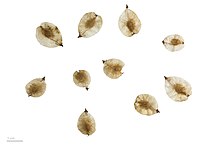Field elm
| Field elm | ||||||||||||
|---|---|---|---|---|---|---|---|---|---|---|---|---|

Field elm ( Ulmus minor ) |
||||||||||||
| Systematics | ||||||||||||
|
||||||||||||
| Scientific name | ||||||||||||
| Ulmus minor | ||||||||||||
| Mill. |
The field elm ( Ulmus minor ) or Iper is a deciduous broadleaf from the family of the Elm Family (Ulmaceae).
description
The field elm reaches heights of between one and 30 meters. The branches often form conspicuous cork strips . Younger parts of the plant are red glandular. The alternate leaves have 8 to 14 side veins, are pointed short and broadest in the middle, the petiole is 8 to 15 mm long and longer than the buds.
The flower has 3 to 7 stamens , forms white stigmas and is often pre-male . It is pollinated by the wind, and the fruits (wing nuts) are also spread by the wind. The flowers and the bare fruits are stalked. The flowering time is in March and April.
The number of chromosomes is 2n = 28.
distribution
The field elm occurs in large parts of Europe, but is on the decline due to the elm disease. It also has habitats in the Canary Islands, North Africa , Asia Minor and the Caucasus .
The field elm occurs both in the lowlands and in the colline altitudes . It prefers partially flooded deciduous or mixed forests, and loves nutrients and lime. In Central Europe it is a character species of the Querco-Ulmetum from the Alno-Ulmion association, but also occurs in societies of the Quercetalia pubescenti-petraeae, Carpinion or Berberidion associations.
Systematics
Synonyms for Ulmus minor Mill. Are: Ulmus campestris L. nom. ambig., Ulmus campestris var. umbraculifera Trautv. , Ulmus carpinifolia Gled. , Ulmus carpinifolia var. Suberosa (Moench) Rehder , Ulmus carpinifolia var. Umbraculifera (Trautv.) Rehder , Ulmus foliacea Gilib. nom. ., Ulmus foliacea var. suberosa (Moench) Rehder , Ulmus foliacea var. umbraculifera (Trautv.) Rehder , Ulmus glabra var. suberosa (Moench) Gürke , Ulmus nitens Moench , Ulmus suberosa Invalidity Moench .
The following subspecies or varieties are distinguished:
- Ulmus minor subsp. angustifolia (Weston) Stace (Syn .: Ulmus minor var. cornubiensis (Weston) RHRichens )
- Ulmus minor subsp. minor (syn. Ulmus carpinifolia Gled. )
- Ulmus minor var. Plotii (Druce) : (Syn .: Ulmus plotii Druce ): Endemic to England.
- Ulmus minor subsp. sarniensis (CK Schneid.) Stace : local endemic in the Channel Islands and in France. Cultivated in much of the UK.
- Ulmus minor var. Vulgaris (Aiton) RHRichens : Native to England, Italy and Spain. (Syn .: Ulmus procera Salisb. ).
use
The leaves were used as fodder for sheep in the Middle Ages. The bark was previously used medicinally. The wood has a beautiful grain and was often used for turning and inlays in the past. But since the Dutch elm died out, the wood has hardly been used economically.
ingredients
The boiled-down brew of field elm bark was previously prescribed against diarrhea , among other things . It contains mucilage, tannins, phlobaphene and phytosterols. The phloem of the plant also contains substances that are similar to antioxidants .
Dutch elm disease
In large parts of Europe the tree is endangered by the Dutch elm disease . This is caused by the fungus Ophiostoma (novo-) ulmi . Older trees with a trunk diameter of approx. 15 cm and more are preferably infested. The damaged trees are sprouting again. So you can almost only find younger plants. Field elms can be 600 years old and 40 m high. The field elm is still more often planted to create hedges and heavily pruned. Here, however , varieties grown in Holland are used almost exclusively , which are usually propagated vegetatively by root shoots.
There are resistant varieties named after the phytopathologists Christine Buisman (1900–1936) and Bea Schwarz (1898–1969), who discovered the cause of Dutch elm disease.
swell
- ↑ a b Erich Oberdorfer : Plant-sociological excursion flora for Germany and neighboring areas . 8th edition. Verlag Eugen Ulmer, Stuttgart 2001, ISBN 3-8001-3131-5 . Page 319.
- ↑ HPT Ammon (Ed.): Pharmaceutical dictionary. De Gruyter, Berlin 2004. ISBN 3-11-017475-8 , p. 1552.
- ^ W. Feucht et al. a .: Localization and quantitative determination of catechins and proanthocyanidins in the phloem of elm and cherry. Tree Physiol. 1992 Mar; 10 (2): 169-77. PMID 14969867
- ↑ Epidemiology. DutchElmDisease.org (English).
Web links
- Field elm. In: FloraWeb.de.
- Profile and distribution map for Bavaria . In: Botanical Information Hub of Bavaria .
- Ulmus minor Mill. In: Info Flora , the national data and information center for Swiss flora . Retrieved October 4, 2015.
- Distribution in the northern hemisphere
- Thomas Meyer: Data sheet with identification key and photos at Flora-de: Flora von Deutschland (old name of the website: Flowers in Swabia )





